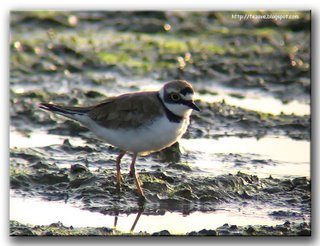LAS DOBLAS (SANLUCAR LA MAYOR-SEVILLA)

Crónica 16/07/2006
Hoy teníamos pensado ir (Diego y yo) al Cerro del Hierro, a hacer un recorrido de 4 km. andando, pero no hemos podido ir porque Diego tenía un compromiso y tenía que estar temprano en Sevilla, de lo cual me alegro porque esta semana he tenido bastante trabajo y no quería andar mucho cargado con el equipo, así que decidimos ir a Las Doblas en Sanlucar la Mayor (Sevilla). Allí se formaron unas grandes balsas de agua a raiz del acondicionamiento del río Guadiamar después del desastre que causó el vertido tóxico por la rotura de la balsa de Aznalcollar. Me llevé mi hide y allí hemos estado haciendo algunas fotos y pasando muchísimo calor. Hoy al estar en el hide no hemos podido observar muchas especies. Se han dejado ver las siguientes:
Today we had thought to go (Diego and I) to the Cerro del Hierro, to doing a tour of 4 km walking, but we could not have gone because Diego had a commitment and had to be early in Seville, about which I am glad because this week I have had enough work and did not want to walk very much loaded with the equipment, so we decide to go to Las Doblas in Sanlucar la Mayor(Seville). There a few big rafts of water were formed immediately after the conditioning of the river Guadiamar after the disaster that caused the spilt toxin for the break of Aznalcollar's oil-raft. I took my hiding place to myself and there we have been doing some photos and suffer a lot of heat. Today on having been in the hiding place we could not have observed many species. We have seen the following ones:
Martinete Común (Nycticorax nycticorax), Garcilla Bueyera (Bubulcus ibis), Garceta Común (Egretta garzetta), Garza Real (Ardea cinerea), Garza Imperial (Ardea purpurea), Flamenco Común (Phoenicopterus ruber), Anade Azulón (Anas platyrhynchos), Milano Negro (Milvus migrans), Cernícalo Vulgar (Falco tinnunculus), Gallineta Común (Gallinula chloropus), Calamón Común (Porphyrio porphyrio), Focha Común (Fulica atra), Cigüeñuela Común (Himantopus himantopus), Chorlitejo Chico (Charadrius dubius), Chorlitejo Grande (Charadrius hiaticula), Chorlitejo Patinegro (Charadrius alexandrinus), Andarríos Grande (Tringa ochropus), Andarríos chico (Actitis hypoleucos), Tórtola Turca (Streptopelia decaocto), Mochuelo Común (Athene noctua), Abejaruco Común (Merops apiaster), Abubilla (Upupa epops), Cogujada Común (Galerida cristata), Golondrina Común (Hirundo rustica), Avión Común (Delichon urbica), Tarabilla Común (Saxicola torquita), Mirlo Común (Turdus merula), Buitrón (Cisticola juncidis), Carricero Común (Acrocephalus scirpaceus), Mosquitero Común (Phylloscopus collybita), Alcaudón Común (Lanius senador), Estornino Negro (Sturnus unicolor), Pico de Coral (Estrilda astrild), Jilguero (Carduelis carduelis).
Eso es todo.
Foto: Chorlitejo Chico (Charadrius dubius)
That's all.
Photo: Little Ringed Plover (Charadrius dubius)
Más fotos en: http://www.galeriade.com/fezave
More photos in: http://www.galeriade.com/fezave







0 Comments:
Publicar un comentario
<< Home